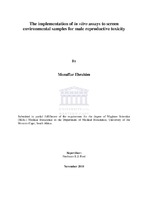| dc.description.abstract | Endocrine disrupting compounds (EDCs) are exogenous compounds/chemicals which interfere with, or have adverse effects on the production, distribution and function of natural hormones, thereby affecting normal endocrine activity, health and quality of life of both humans and wildlife. The reproductive system is highly susceptible to EDCs due to it being controlled by an array of hormonal signals. The effects of EDCs on the male reproductive system include infertility, decreased sperm count, function and morphology, abnormal development of secondary sex characteristics, reproductive function and sexual behaviour as well as decreased libido. There are various sources by which EDCs enter the environment which include effluents from several industries (mining, agriculture, smelting, hazardous waste sites, manufacturing industries, etc.), sewage treatment effluents, urban and agricultural runoff and effluents which include natural and pharmaceutical chemicals excreted in the urine of humans and domestic livestock, pesticides, polychlorinated biphenyls, dioxins, plasticizers, surfactants, etc. Humans and animals can also be affected by EDCs by consuming food containing endocrine active substances. The growing concern regarding adverse effects due to EDC exposure of humans and wildlife, as well as the increased incidence of EDC contamination has prompted extensive research into the development and validation of screening tests to detect and monitor known EDCs and new substances with endocrine-disrupting capability. These screening tests involve assessing the effect of known and potential EDCs on reproductive function and development as well as hormone production. To assess the effect of EDCs on the reproductive system different methods are employed which include in vitro, in vivo and ex vivo methods. In vitro methods have been suggested as a suitable screening tool for EDC monitoring due to low costs, reduced animal usage, the use of standard and basic equipment as well as the ability to screen a large number of samples with multiple endpoints. Of the available in vitro methods, the minced testes method has been suggested as the most suitable method for screening EDCs and for this reason has been employed in this study. The aim of this study was thus to employ a minced testes method to screen samples for male reproductive toxicity using cell viability and hormone production (testosterone and estradiol) as endpoints.The first objective of this study was to optimize an in vitro testicular cell culture assay by determining both optimal luteinizing hormone (LH) concentration and incubation time needed for testosterone production. Testicular cell cultures were prepared and cells were treated with varying concentrations of LH (10, 1, 0.1, 0.01 and 0 mu/ml) and incubated for 4 hours and 20 hours. Testosterone production was evaluated for each incubation period. Testosterone production was significantly increased for both incubation periods at all LH concentrations tested as compared to the control. For both incubation periods, there was no significant difference in testosterone production between the different LH concentrations tested. From the data obtained, the 4 hour incubation period as well as the LH concentration of 10 mu/ml were selected as optimal for the testicular cell culture assay. The second objective of this study was to determine the effect of Tulbaghia violacea Harv. on the male reproductive system. T. violacea is a plant species indigenous to southern Africa and is used locally as a herbal remedy/medicine to treat several ailments. Cells were treated with varying concentrations of the T. violacea ethanol extract (with/without LH-treatment) and incubated for 4 hours. Hormone production and cell viability were evaluated. The results obtained from this pilot in vitro study demonstrated that the ethanol extract of T.violacea has androgenic properties by significantly increasing LH-induced testosterone production in mouse testes with no significant change in cell viability. The third objective of this study was to assess the effect of Sutherlandia frutescens(L.) R.Br and Artemisia afra Jacq. Ex Willd. on the male reproductive system. S. frutescens and A. afra are also plant species indigenous to southern Africa and used locally as a herbal remedy/medicine to treat several ailments. Ethanol extracts of each plant was prepared and cells were treated with varying concentrations of each extract (0, 156.25, 312.5, 625, 1250,2500 and 5000 μg/ml) with or without LH-treatment and incubated for 4 hours. Cytotoxicity by LDH measurement and hormone production (testosterone and estradiol) were endpoints that were evaluated. The results obtained showed that the ethanol extracts of both plants are not cytotoxic to testicular cells and that A. afra decreases testosterone production at high concentrations. The fourth and final objective of this study was to assess the acute effect of four heavy metals, namely manganese, copper, cadmium and magnesium on the male reproductive system. These heavy metals are used extensively in manufacturing and mining industries. Cells were treated with varying concentrations of each metal salt (200, 100, 50, 25, 12.5, and 6.25 & mu;M) with or without LH-treatment and incubated for 4 hours. Endpoints evaluated included cell viability, testosterone and estradiol production. The results obtained showed that manganese, cadmium and copper are highly toxic to testicular cells in vitro and therefore may potentially cause reproductive toxicity. | en_US |

